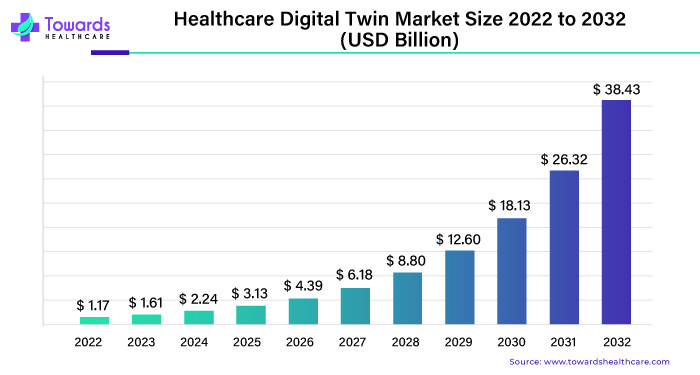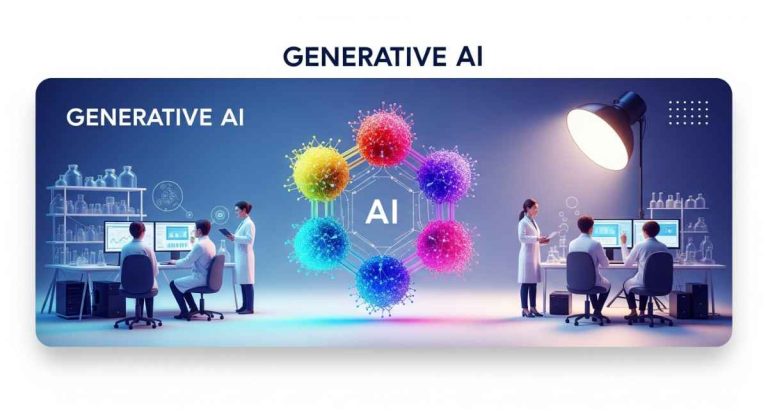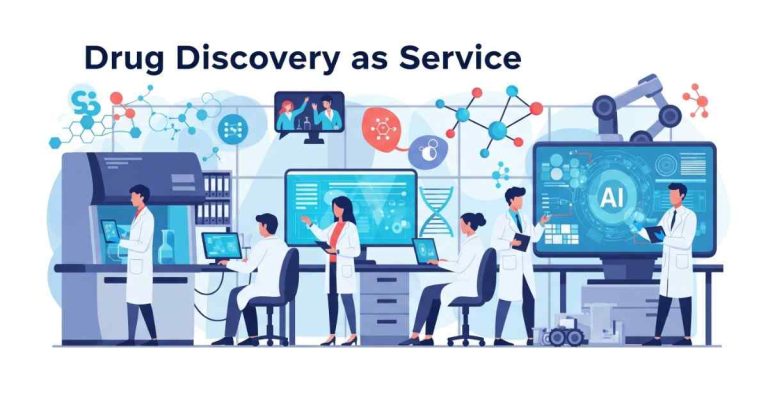Healthcare Digital Twin Market Report Highlights:
- The global healthcare digital twin market size was valued at USD 1.17 billion in 2022.
- Estimated to become USD 38.43 billion market by 2032.
- Projected to grow at 42.2% CAGR.
- The software segment dominated in 2022 with a whopping 65.8% share.
- The personalized treatment management segment by application claimed a hefty 39.6% market share in 2022.
- The surgical planning and risk assessment segment by application is projected to grow at a staggering 19.7% CAGR from 2023-2032.

Download statistics of this report @ https://www.towardshealthcare.com/download-statistics/5095
As per the World Heart Federation report, cardiovascular diseases impact over 500 million people globally, leading to 20.5 million deaths in 2021. The growing importance of digital twins in cardiovascular care highlights their potential to revolutionize the industry by providing more accurate diagnoses.
A digital twin is a sophisticated concept that combines various technological advancements to create a virtual counterpart of a physical object or system. In this context, it’s mainly applied to healthcare. The process begins by outfitting the physical object with sensors, such as a part of the human body or a medical device. These sensors continuously collect data on temperature, energy output, and other vital performance metrics.
This data is then sent to a processing system where it’s applied to the digital twin. Now enriched with real-time data, the virtual model becomes a powerful tool for running simulations and conducting in-depth performance analyses. It goes beyond a static representation and becomes a dynamic entity that evolves based on the incoming data. Integrating big data, cloud computing, virtual reality, and IoT facilitates the creation and operation of such digital twins in healthcare. Researchers and engineers are actively exploring the potential of digital twins in healthcare, expanding the initial definition to include digital replications relevant to human health.
For Instance,
- A digital twin in healthcare can replicate organs, tissues, cells or even the micro-environment within a patient’s body. It doesn’t just create a snapshot but adjusts in real-time to variations in data, predicting potential future states, defects, damages or failures.
The technology supporting digital twins is multifaceted. It includes statistical models driven by data, where algorithms process and analyze large datasets and mechanical models that integrate knowledge across different scales. Artificial intelligence (AI) models, trained with samples and numerical data, are crucial in obtaining real-time structural performance insights from sensor data. The application of digital twins in healthcare holds immense potential. Healthcare professionals can optimize diagnostics and treatments by treating patients as virtual assets. The technology is not confined to a single patient but can extend to entire healthcare organizations, enhancing strategic asset management.
The global market for digital twin technology is experiencing a surge, revolutionizing various industries, with healthcare being a significant beneficiary. However, challenges persist in the widespread adoption of digital twins in digital healthcare. Overcoming data privacy, interoperability, and standardization issues is essential for unlocking this transformative technology’s full potential in the medical field. As digital twin technology continues to evolve, it presents numerous opportunities for advancing medicine, but collaboration and addressing existing challenges are crucial for its seamless integration into healthcare systems worldwide.
Digital twin technology is reshaping various industries, effectively enhancing efficiency and issue detection for significant companies. Extending its transformative potential, healthcare emerges as a promising domain for applying DT. In practical terms, DT can be viewed as a tool treating patients as virtualized standalone assets, applicable in diverse environments involving multiple interconnected strategic assets within healthcare organizations. This approach holds significant promise for patients and hospitals, offering improvements in treatment methodologies and diagnostic processes. The primary goal of this study is to conduct a comprehensive review of the advancements in DT technology within the medical field. The focus is on exploring potential applications, identifying future opportunities and addressing the challenges in digital healthcare.
Digital Twin Boosting Precision in the CVS Disease Diagnosis
Digital twin technology is revolutionizing the field of cardiovascular healthcare by enabling the creation of highly accurate heart models for precise diagnosis and treatment. These digital replicas are pivotal in identifying crucial diagnostic criteria and inferring biomarkers through non-invasive procedures. The success of DT-guided diagnosis hinges on constructing personalized models that customize the approach to individual patients.
The advancement is in the computation of pressure drops in flow obstruction, where the personalized DT approach has proven to be more effective than traditional clinical guidelines. This innovation enhances the accuracy of diagnosis, allowing for more targeted and efficient treatment strategies.
- In 2023, Philips, one of the leading healthcare technology companies, took a significant step in this direction by developing a customized DT model based on unique computed tomography (CT) heart images. This personalized model contributes to a more precise diagnosis and facilitates surgical planning. Implementing the HeartNavigator tool consolidates CT images into a cohesive 3D representation, providing surgeons real-time insights into device positioning during cardiac surgeries. This not only streamlines the pre-procedural planning but also assists surgeons in selecting and placing devices more effectively.
- In 2021, HeartFlow Analysis have emerged to offer a more comprehensive evaluation of coronary artery disease. The American College of Cardiology and the American Heart Association (AHA) designated the HeartFlow FFRCT Analysis as Class 2a. This approach goes beyond traditional methods, providing functional information that can significantly improve patient outcomes. By incorporating advanced analytical tools and algorithms, HeartFlow Analysis enhances the understanding of cardiovascular conditions, aiding clinicians in making more informed decisions.
- In 2022, the Acorys Mapping system represents a noteworthy development in non-invasive monitoring. This electrocardiographic system combines a biopotential amplifier with a high-density sensor and innovative image and signal processing technologies. The result is an entirely non-invasive way to capture electrical activity on the surface of the heart. This minimizes patient discomfort and provides valuable data for diagnostic purposes.
The global market for digital twin technology in healthcare is experiencing substantial growth, driven by these groundbreaking advancements. The increasing significance of DT in cardiovascular care underscores its potential to transform the industry by offering more accurate diagnoses, personalized treatment plans and improved patient outcomes. As these technologies continue to evolve, integrating digital twins into routine clinical practice will likely become more prevalent, shaping the future of cardiovascular healthcare.
Impact of Covid-19
The COVID-19 pandemic has sparked widespread interest in the modelling and simulating infectious diseases. Transmission of coronaviruses primarily occurs through respiratory droplets during person-to-person contact, mainly through coughing or sneezing. Zohdi has innovatively crafted a computationally efficient respiratory emission model, integrating a combined digital twin technology and a machine learning approach. This framework, employing a genomic algorithm and simplified equations, optimizes ventilation systems by determining multiple units’ strategic placement and flow rates. The aim is to effectively contain and sequester particles released during coughing or sneezing, thus mitigating the spread of the virus.
Additionally, the government introduced a DT system for the vaccination process in response to the urgent need to vaccinate a larger population in a shorter timeframe, mainly when healthcare resources are limited. This system has undergone clinic testing and enables real-time patient simulation, creating a dynamic virtual vaccination centre. The virtual model allows for identifying and resolving issues within the actual system, thereby enhancing the overall efficiency of the vaccination process. In light of the COVID-19 pandemic, there has been a noticeable surge in the adoption of digital twin technology across various applications, as these technologies play a crucial role in addressing challenges posed by the pandemic and optimizing processes for better outcomes in healthcare.
Discover our detailed Table of Contents (TOC) for the Industry, providing a thorough examination of market segments, material, emerging technologies and key trends. Our TOC offers a structured analysis of market dynamics, emerging innovations, and regional dynamics to guide your strategic decisions in this rapidly evolving healthcare field – https://www.towardshealthcare.com/table-of-content/healthcare-digital-twin-market-size
To own our research study instantly, Click here @ https://www.towardshealthcare.com/price/5095
You can place an order or ask any questions, please feel free to contact us at sales@towardshealthcare.com
About Us
Towards Healthcare is a leading global provider of technological solutions, clinical research services, and advanced analytics to the healthcare sector, committed to forming creative connections that result in actionable insights and creative innovations. We are a global strategy consulting firm that assists business leaders in gaining a competitive edge and accelerating growth. We are a provider of technological solutions, clinical research services, and advanced analytics to the healthcare sector, committed to forming creative connections that result in actionable insights and creative innovations.
Explore the comprehensive statistics and insights on healthcare industry data and its associated segmentation: Get a Subscription
For Latest Update Follow Us: https://www.linkedin.com/company/towards-healthcare



